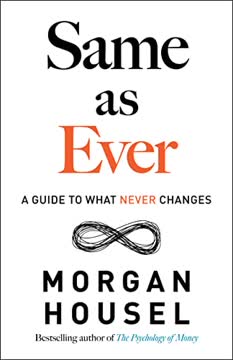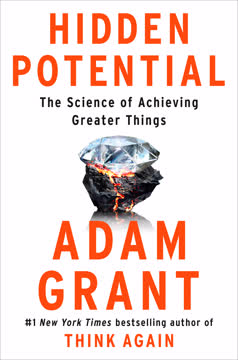Key Takeaways
1. Words shape identity and drive action
"By framing actions as a way to claim desired identities or selves, turning actions into identities can actually shift the actions others take."
Identity-driven language. Subtle shifts in wording can significantly impact behavior. By transforming verbs into nouns (e.g., "help" to "helper"), we create opportunities for people to embody positive identities. This technique has been shown to increase voter turnout, encourage ethical behavior, and motivate children to assist others.
Empowering self-talk. The way we talk to ourselves matters. Changing "can't" to "don't" when facing temptation increases our sense of control and improves goal adherence. Similarly, using "could" instead of "should" when problem-solving enhances creativity by opening up possibilities rather than focusing on obligations.
Strategic pronoun use. Talking to oneself in the third person can reduce anxiety and improve performance by creating psychological distance. However, the use of "you" in communication can be double-edged – it can draw attention and increase relevance in social media contexts, but may imply blame or responsibility in customer service situations.
2. Speaking with confidence amplifies influence
"Rather than just conveying facts and opinions, words communicate how certain we are about those facts and opinions."
Eliminating hesitation. Filler words like "um" and "uh" significantly undermine perceived competence and authority. By practicing pausing instead of using these verbal crutches, speakers can appear more confident and persuasive.
Leveraging definitive language. Words like "definitely," "clearly," and "obviously" remove doubt and signal certainty. This confident language makes listeners more likely to trust and follow the speaker's suggestions.
Present tense power. Using present tense rather than past tense (e.g., "the restaurant is great" vs. "was great") implies ongoing truth and increases persuasiveness. This simple shift makes opinions seem more universal and enduring.
When to express doubt:
- In contentious discussions to signal openness
- When acknowledging nuance or complexity
- To build trust in scientific communication
3. Asking the right questions deepens connections
"By understanding what makes a good story, we can all become better storytellers."
The power of follow-ups. Asking follow-up questions demonstrates genuine interest and responsiveness, leading to stronger connections. In dating scenarios, follow-up questions significantly increase the likelihood of a second date.
Deflecting with questions. When faced with difficult or unfair questions, responding with a related question allows for redirection while maintaining engagement. This technique is particularly useful in negotiations and interviews.
Building intimacy gradually. The "Fast Friends" technique developed by psychologists Arthur and Elaine Aron demonstrates how strategically sequenced questions can rapidly build closeness between strangers. Starting with safe, easy-to-answer questions before progressing to more personal topics creates a foundation of trust and mutual vulnerability.
Key principles:
- Start with low-risk questions
- Gradually increase depth and intimacy
- Ensure reciprocal sharing
- Allow for natural conversation flow
4. Concrete language enhances understanding and impact
"To make people feel heard, we have to show them that we listened."
Signaling attentiveness. Using specific, concrete language demonstrates that you've truly listened and understood. In customer service interactions, concrete responses (e.g., "I'll search for that gray T-shirt") are perceived as more attentive than abstract ones (e.g., "I'll look for that").
Overcoming the curse of knowledge. Experts often communicate abstractly, assuming others share their depth of understanding. Making abstract concepts concrete through specific examples, analogies, and vivid language helps bridge this gap and improves comprehension.
Strategic abstraction. While concrete language is generally beneficial, abstract language can be advantageous in certain contexts. Startup founders pitching investors, for example, may benefit from using more abstract language to convey growth potential and visionary thinking.
When to use concrete vs. abstract language:
- Concrete: For understanding, memorability, and showing attentiveness
- Abstract: To signal leadership, potential, and big-picture thinking
5. Emotional storytelling captivates audiences
"Low points, or depths of despair, make the high points that much more powerful."
The roller coaster principle. Stories that alternate between emotional highs and lows are more engaging than those that maintain a consistent positive tone. This emotional volatility keeps audiences invested and heightens the impact of positive moments.
Contextual emotionality. The effectiveness of emotional language depends on the context. For hedonic products or experiences (e.g., restaurants, vacations), emotional language increases appeal. For utilitarian products (e.g., toasters, software), overly emotional language can backfire.
Harnessing uncertainty. Content that evokes uncertain emotions (e.g., anxiety, surprise) tends to hold attention better than content evoking certain emotions. This "curiosity gap" keeps audiences engaged as they seek resolution.
Emotional storytelling tips:
- Intersperse highs and lows
- Create moments of unpredictability
- Match emotional tone to context
- Use uncertain emotions to maintain engagement
6. Linguistic similarity and difference affect success
"Speed was good. Books, movies, and TV shows with faster plot progression were liked more than their slower-moving counterparts."
Adapting to cultural fit. In workplace settings, employees whose linguistic style matches their colleagues' are more likely to be promoted and less likely to be fired. This linguistic adaptation signals cultural assimilation and predicts long-term success within an organization.
Standing out through difference. In creative fields, atypicality can drive success. Songs with lyrics that diverge from genre norms tend to be more popular. This principle extends to other cultural products like movies and books.
Optimizing story pacing. The speed at which a narrative progresses impacts audience engagement. Generally, starting slowly to establish context before increasing pace leads to greater success. However, the optimal progression depends on the goal (entertainment vs. information).
Factors influencing linguistic similarity/difference:
- Professional context (e.g., corporate vs. creative fields)
- Audience expectations
- Communication goals (fitting in vs. standing out)
7. Language reveals hidden truths about people and society
"Even if people aren't communicating strategically or consciously trying to speak one way or another, just like Shakespeare and Theobald, the words they use provide telltale signals of all sorts of interesting and important things."
Predicting behavior. The language people use can predict future actions, even when they're unaware of it. For example, the words used in loan applications can indicate the likelihood of repayment, outperforming traditional financial metrics.
Uncovering societal biases. Large-scale analysis of song lyrics, books, and other cultural products reveals subtle gender biases and how they've evolved over time. This linguistic archaeology provides insights into societal attitudes and prejudices.
Exposing systemic issues. Examination of police body camera footage demonstrates how officers use less respectful language when interacting with Black motorists compared to White motorists, revealing subtle but pervasive racial disparities in law enforcement.
Applications of language analysis:
- Forensic linguistics (e.g., authorship attribution)
- Predicting financial behavior
- Measuring societal attitudes and biases
- Identifying systemic discrimination
- Improving customer analytics and targeting
Last updated:
FAQ
What's "Magic Words" by Jonah Berger about?
- Exploration of Language: "Magic Words" by Jonah Berger delves into the power of language and how specific words can influence behavior, persuade others, and drive action.
- Six Types of Magic Words: The book categorizes these impactful words into six types: words that activate identity and agency, convey confidence, ask the right questions, leverage concreteness, employ emotion, and harness similarity (and difference).
- Practical Applications: Berger provides insights into how these words can be used effectively in various contexts, from personal interactions to professional settings, to enhance communication and achieve desired outcomes.
Why should I read "Magic Words" by Jonah Berger?
- Enhance Communication Skills: The book offers practical advice on using language more effectively to persuade, engage, and connect with others.
- Scientific Insights: It combines research from psychology and linguistics to provide a deeper understanding of how words influence human behavior.
- Real-World Examples: Berger uses relatable examples and case studies to illustrate the impact of language, making the concepts accessible and applicable to everyday life.
What are the key takeaways of "Magic Words" by Jonah Berger?
- Power of Specific Words: Certain words, when used strategically, can significantly increase persuasion and influence.
- Language Reflects and Reveals: Words not only impact others but also reveal insights about the speaker's identity, intentions, and societal biases.
- Adaptability and Context: The effectiveness of language depends on context and adaptability, highlighting the importance of choosing the right words for different situations.
How does Jonah Berger categorize magic words in "Magic Words"?
- Identity and Agency: Words that suggest who is in charge and what it means to engage in an action.
- Confidence: Language that conveys certainty and authority, influencing how others perceive the speaker.
- Questions: The art of asking the right questions to gather information and build connections.
- Concreteness: Using specific, vivid language to make ideas more understandable and memorable.
- Emotion: Employing emotional language to engage and persuade audiences.
- Similarity and Difference: Understanding when to align with others linguistically and when to stand out.
What is the significance of "because" in "Magic Words"?
- Persuasive Power: The word "because" significantly increases compliance and persuasion by providing a reason, even if the reason is not particularly strong.
- Copy Machine Study: Berger references a study where adding "because" to a request increased compliance by over 50%, demonstrating its impact.
- Psychological Insight: The word taps into a psychological need for justification, making requests seem more legitimate and reasonable.
How does Jonah Berger suggest using language to convey confidence?
- Ditch the Hedges: Avoid using hedges like "might" or "could" that suggest uncertainty and weaken statements.
- Use Definites: Employ words like "definitely" and "clearly" to convey certainty and authority.
- Present Tense: Use present tense to suggest ongoing truth and stability, making statements more persuasive.
What role do questions play in "Magic Words" by Jonah Berger?
- Building Connections: Asking questions shows interest and engagement, fostering deeper connections and likability.
- Types of Questions: Berger emphasizes the importance of follow-up questions and avoiding assumptions to gather more accurate information.
- Strategic Deflection: Use questions to deflect difficult inquiries and maintain control of conversations.
How does Jonah Berger explain the use of concreteness in language?
- Specificity Matters: Concrete language makes communication clearer and more memorable by providing vivid details.
- Customer Satisfaction: Using concrete language in customer service can increase satisfaction by showing attentiveness and understanding.
- Overcoming the Curse of Knowledge: Avoid abstract jargon that may confuse others, especially when explaining complex ideas.
What is the pratfall effect mentioned in "Magic Words"?
- Humanizing Mistakes: The pratfall effect suggests that competent people become more likable when they make small mistakes, as it makes them more relatable.
- Context Matters: The effect is beneficial only when the person is already perceived as competent; otherwise, mistakes can reinforce negative perceptions.
- Storytelling Technique: Berger uses this concept to explain how sharing failures alongside successes can create more engaging and relatable narratives.
How does "Magic Words" address the concept of linguistic similarity?
- Fitting In: Linguistic similarity can enhance social bonds and increase success in environments where fitting in is valued.
- Predictive Power: Similarity in language use can predict outcomes like job promotions and relationship success.
- Balancing Difference: While similarity is beneficial in some contexts, standing out linguistically can drive creativity and success in others.
What does "Magic Words" reveal about societal biases through language?
- Subtle Biases: Language can reveal underlying societal biases, such as gender stereotypes and racial disparities.
- Cultural Reflection: Analyzing language in media and everyday interactions can provide insights into broader cultural attitudes and prejudices.
- Potential for Change: By understanding these biases, individuals and organizations can work towards more equitable communication practices.
What are the best quotes from "Magic Words" and what do they mean?
- "Words have power." This quote encapsulates the central theme of the book, emphasizing the significant impact language can have on influencing behavior and shaping perceptions.
- "The right words, used at the right time, can change minds, engage audiences, and drive action." This highlights the strategic use of language to achieve specific goals, whether in personal or professional contexts.
- "Language not only influences others but also reflects and reveals the speaker's identity and intentions." This underscores the dual role of language in both affecting others and providing insights into the speaker's own characteristics and societal norms.
Review Summary
Magic Words explores the power of language in influencing behavior and decision-making. Berger presents six types of words that can enhance communication and persuasion. While some readers found the book insightful and practical, others felt it lacked depth or relied on questionable studies. Many appreciated Berger's engaging writing style and real-world examples. The book offers strategies for activating identity, conveying confidence, asking effective questions, and leveraging emotions in various contexts. Overall, it's considered a quick, informative read for those interested in communication and human behavior.
Similar Books










Download PDF
Download EPUB
.epub digital book format is ideal for reading ebooks on phones, tablets, and e-readers.








